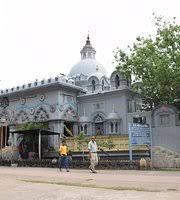Located in the serene city of Agartala, the Laxmi Narayan Temple is a symbol of divine grace and cultural heritage. Dedicated to Lord Vishnu and his consort Goddess Lakshmi, this ancient temple is an essential place of worship and a significant landmark for the people of Tripura. The Laxmi Narayan Temple stands as a testament to the state’s rich religious and architectural traditions, attracting pilgrims and tourists alike with its tranquility and spiritual aura.
For those seeking spiritual solace or simply wanting to explore the culture of Agartala, the Laxmi Narayan Temple offers a peaceful sanctuary. This blog delves into the temple’s history, its religious and spiritual significance, architectural beauty, festivals, and the unique visitor experience it offers.
Historical Significance of Laxmi Narayan Temple
1. The Royal Connection
Constructed in the 19th century under the reign of the Tripura Kings, the Laxmi Narayan Temple was part of a broader effort by the royal family to establish and promote Hindu culture and practices within the region. The kings of Tripura were known for their devotion to Hinduism, and this temple stands as a reflection of their commitment to religious and cultural enrichment. The temple continues to serve as an important center of worship for locals and visitors alike.
2. Growth and Influence
Over the years, the temple gained prominence as a place of spiritual significance. It became a focal point for the local community and people from neighboring regions. Today, the Laxmi Narayan Temple holds great historical significance, both for its religious importance and for being a reminder of the rich heritage of Tripura.
Architectural Splendor of Laxmi Narayan Temple
The architectural design of the Laxmi Narayan Temple is one of its most striking features, showcasing a blend of traditional Hindu temple architecture with influences from the Bengali style. Visitors are often in awe of the grandeur of the structure, its intricate details, and the artistic mastery behind its construction.
1. Majestic Exterior
The temple’s exterior is characterized by intricate carvings of Hindu deities, mythological stories, and decorative motifs. The tall shikhara (spire) that rises above the temple is a defining feature of its architecture. This towering structure symbolizes the connection between the earthly and divine realms, pointing toward the heavens.
2. The Main Sanctum
Inside the temple, the main sanctum houses the idol of Lord Vishnu with Goddess Lakshmi seated beside him. The idol of Vishnu is depicted in a serene posture, with four arms holding sacred items such as the conch, discus, mace, and lotus, which are significant symbols in Hindu mythology.
3. The Courtyard and Surroundings
The temple is set amidst a beautifully landscaped courtyard that is perfect for meditation and reflection. The lush greenery surrounding the temple adds to its serene ambiance, creating a peaceful space for prayer and contemplation. The temple’s architecture, coupled with its natural surroundings, enhances its spiritual atmosphere, making it a perfect place to escape from the hustle and bustle of daily life.
Religious and Spiritual Importance of Laxmi Narayan Temple
The Laxmi Narayan Temple holds profound religious and spiritual significance for the people of Agartala and the surrounding areas. Dedicated to Lord Vishnu and Goddess Lakshmi, the temple serves as a place where devotees can seek blessings for prosperity, good health, and peace. The temple also reflects the deep-rooted Hindu beliefs that play an essential role in the cultural identity of Tripura.
1. Lord Vishnu: The Preserver of the Universe
As one of the principal deities of Hinduism, Lord Vishnu is considered the preserver of the universe. He is believed to maintain the cosmic order, ensuring that harmony and balance are upheld in the world. Devotees visit the Laxmi Narayan Temple to offer their prayers to Lord Vishnu, seeking his protection, blessings, and guidance.
2. Goddess Lakshmi: The Harbinger of Prosperity
Goddess Lakshmi, the consort of Lord Vishnu, is revered as the goddess of wealth, prosperity, and abundance. In Hindu tradition, it is believed that Goddess Lakshmi brings good fortune and material success to those who worship her with sincerity and devotion. Devotees come to the Laxmi Narayan Temple to pray for financial well-being, success in endeavors, and spiritual growth.
3. Spiritual Benefits
For many visitors, the Laxmi Narayan Temple is not just a place for material gain but also for spiritual enrichment. The peaceful surroundings, the beautiful idol of Lord Vishnu, and the overall atmosphere of the temple create an environment conducive to meditation, prayer, and self-reflection. Many people visit the temple to seek inner peace and divine blessings, away from the distractions of everyday life.
Festivals and Celebrations at Laxmi Narayan Temple
The Laxmi Narayan Temple is a vibrant hub of religious activity, especially during key Hindu festivals. These celebrations attract thousands of devotees, who come to the temple to participate in prayers, rituals, and community events. The most significant of these festivals are:
1. Diwali: The Festival of Lights
Diwali, the festival of lights, is one of the grandest celebrations at the Laxmi Narayan Temple. This festival, which marks the triumph of light over darkness and good over evil, sees the temple illuminated with oil lamps and candles. Devotees flock to the temple to seek the blessings of Lord Vishnu and Goddess Lakshmi, believing that worshiping them during Diwali ensures wealth, prosperity, and happiness.
2. Janmashtami: Celebrating Lord Krishna’s Birth
Janmashtami, the celebration of Lord Krishna’s birth, is another major festival at the Laxmi Narayan Temple. Devotees gather at the temple to sing devotional songs, offer prayers, and participate in religious ceremonies.
3. Other Hindu Festivals
In addition to Diwali and Janmashtami, the temple also celebrates other important festivals such as Holi, Durga Puja, and Navaratri. These festivals bring the temple to life with rituals, music, dance, and feasts, offering a chance for the community to come together in devotion and celebration.
Visitor Experience at Laxmi Narayan Temple
The Laxmi Narayan Temple provides an enriching experience for all visitors. Whether you are a devotee seeking divine blessings, a tourist interested in learning about the cultural heritage of Tripura, or someone in search of a peaceful place for reflection, the temple offers a warm welcome.
Visitors can take a stroll through the temple’s beautiful courtyard, marvel at the intricate carvings, participate in prayers, and learn about the temple’s history and religious significance. The calm environment of the temple offers visitors a chance to disconnect from the fast-paced world and connect with their spiritual self.
How to Reach Laxmi Narayan Temple
Located in the heart of Agartala, the Laxmi Narayan Temple is easily accessible from all parts of the city.
1. By Taxi or Car
The most convenient way to reach the temple is by taxi or car. It takes around 10-15 minutes from the Agartala city center to the temple.
2. By Public Transport
For those traveling by public transport, buses and auto-rickshaws are available to take visitors to the temple. The temple is located close to several popular landmarks in Agartala, making it easy to navigate by local transport.
Conclusion
The Laxmi Narayan Temple in Agartala is not just a place of worship but a living testament to the rich cultural and spiritual heritage of Tripura. With its majestic architecture, deep-rooted religious significance, and vibrant celebrations, it offers a serene and enlightening experience for all visitors. Whether you seek divine blessings or simply wish to immerse yourself in the peaceful atmosphere, the Laxmi Narayan Temple is a destination that promises to leave you spiritually enriched and connected to the divine.





